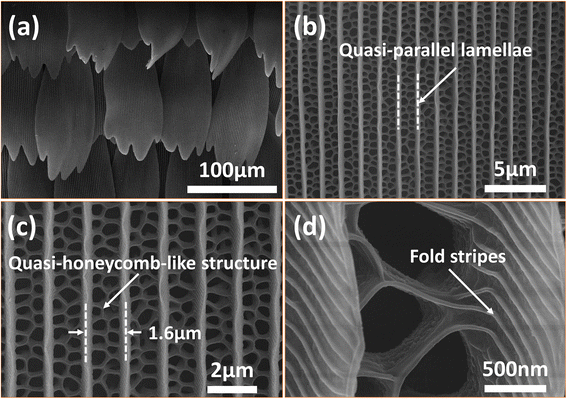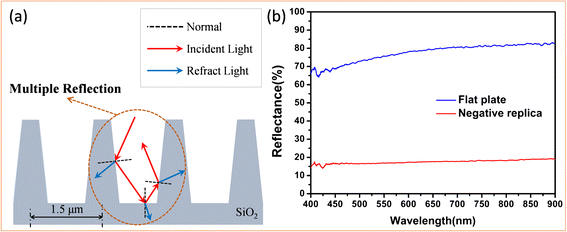An Ingenious Super Light Trapping Surface Templated from Butterfly Wing Scales
- PMID: 26306539
- PMCID: PMC4549356
- DOI: 10.1186/s11671-015-1052-7
An Ingenious Super Light Trapping Surface Templated from Butterfly Wing Scales
Abstract
Based on the super light trapping property of butterfly Trogonoptera brookiana wings, the SiO2 replica of this bionic functional surface was successfully synthesized using a simple and highly effective synthesis method combining a sol-gel process and subsequent selective etching. Firstly, the reflectivity of butterfly wing scales was carefully examined. It was found that the whole reflectance spectroscopy of the butterfly wings showed a lower level (less than 10 %) in the visible spectrum. Thus, it was confirmed that the butterfly wings possessed a super light trapping effect. Afterwards, the morphologies and detailed architectures of the butterfly wing scales were carefully investigated using the ultra-depth three-dimensional (3D) microscope and field emission scanning electronic microscopy (FESEM). It was composed by the parallel ridges and quasi-honeycomb-like structure between them. Based on the biological properties and function above, an exact SiO2 negative replica was fabricated through a synthesis method combining a sol-gel process and subsequent selective etching. At last, the comparative analysis of morphology feature size and the reflectance spectroscopy between the SiO2 negative replica and the flat plate was conducted. It could be concluded that the SiO2 negative replica inherited not only the original super light trapping architectures, but also the super light trapping characteristics of bio-template. This work may open up an avenue for the design and fabrication of super light trapping materials and encourage people to look for more super light trapping architectures in nature.
Figures





References
-
- Anjusree GS, Bhupathi A, Balakrishnan A, Vadukumpully S, Subramanian KRV, Sivakumar N, et al. Fabricating fiber, rice and leaf-shaped TiO2 by tuning the chemistry between TiO2 and the polymer during electrospinning. RSC Adv. 2013;3:16720–7. doi: 10.1039/c3ra42250j. - DOI
-
- Nishimoto S, Bhushan B. Bioinspired self-cleaning surfaces with superhydrophobicity, superoleophobicity, and superhydrophilicity. RSC Adv. 2013;3:671–90. doi: 10.1039/C2RA21260A. - DOI
-
- Liu Y, Li SY, Zhang JJ, Wang YM, Han ZW, Ren LQ. Fabrication of biomimetic superhydrophobic surface with controlled adhesion by electrodeposition. Chem Eng J. 2014;248:440–7. doi: 10.1016/j.cej.2014.03.046. - DOI
-
- Koch K, Bhushan B, Jung YC, Barthlott W. Fabrication of artificial lotus leaves and significance of hierarchical structure for superhydrophobicity and low adhesion. Soft Matter. 2009;5:1386–93. doi: 10.1039/b818940d. - DOI
LinkOut - more resources
Full Text Sources
Other Literature Sources

